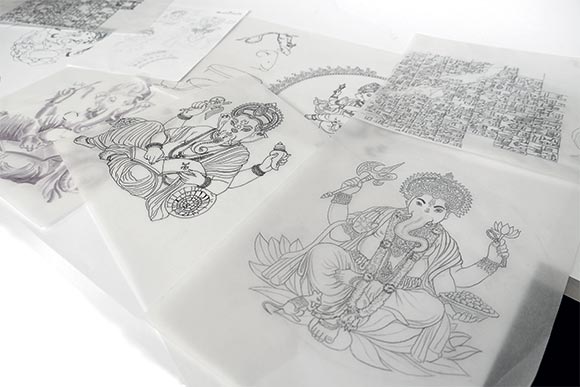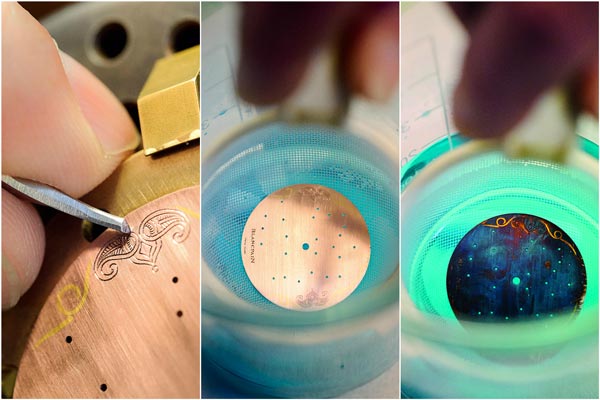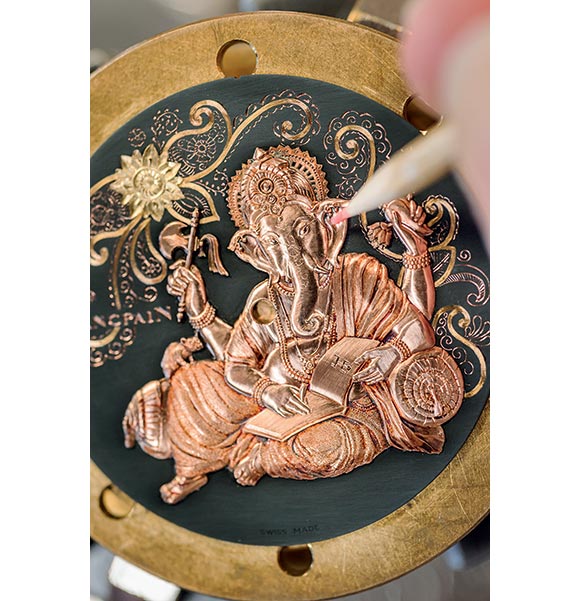It is not an altogether obvious proposition that a centuries old Japanese art form favored by samurai to embellish small elements of their katana (long swords) would find its way to Switzerland’s Vallée de Joux for Blancpain’s artisans to create special one- of-a-kind watch dials. Then, after spending a day with Christophe Bernardot who heads Blancpain’s métiers d’art studio, it seems only natural.
Métiers d’art occupy a privileged place in horology. Enabled by the invention of the main spring, the first portable pocket watches emerged in the 15th century. Accuracy was far from the forte of these early time- pieces. Indeed, they were so imprecise that some came equipped a sun dial so that the owner could have at his disposal a ready reference for the actual time of day. With their mechanical worth so questionable, watchmakers turned to art as the means to show the value of their creations. Enameling, engraving and gilding were all lavished upon these early timepieces demonstrating not only the worth of the watch but that of the owner. Following the invention of the balance wheel which occurred in the late 1600s which finally enabled watchmakers to create precise rate keeping mechanisms and, thereafter, complications, métiers d’art, so previously well established, continued to flourish alongside mechanical innovations.
With its respect for the grand traditions of watchmaking handcraft, Blancpain has woven métiers d’art into its timepieces and collections. There is one vital respect, however, where Blancpain’s embrace and practice de- parts from that of the vast majority of haute horlogerie houses. Whereas others choose to look outside their walls to find artists skilled in these crafts, Blancpain has brought them in-house into its workshop in Le Brassus.

Directing the Blancpain métiers d’art studio is Christophe Bernardot. By training he is an artist who graduated from the École régionale des beaux-arts in Besançon. What followed were years working in different media. Initially, it was with Porcelaine de Sèvres in Paris where he created elaborate porcelain table decorations exclusively reserved for a single customer: the French state. Bernardot’s creations, intriguingly called biscuits de Sèvres as they were fired two times, graced the tables in the Élysée Palace and French embassies. This sculpture work was followed by years of engraving, creating gold perfume bottle stoppers in Besançon. Spreading his wings yet further, he turned to enameling, spending ten years practicing all of the traditional enamel crafts of fine painting, cloisonné (where fine gold threads are placed upon a surface and enamel added to fill in the areas formed by the threads) and champlevé (where areas are carved out of surface and enamel used to fill in the voids). His training, thus, brings a complete repertoire of crafts to the Le Brassus studio: sculpture, engraving, and the full breadth of enameling motifs.

In the Blancpain studio, he has surrounded himself with talented artists practicing the full range of métiers d’art specialties: engraving of movement bridges and winding rotors, damascene, enamel work in multiple forms, carving of automat figures for minute repeaters, and, of course, the principal subject of this article, shakudō. These artists bring with them their own portfolios and impressive credentials. Indeed, one of the master engravers, Marie-Laure Tarbouriech, won first prize for engraving in the French “Un des Meilleurs Ouvriers de France” competition (“Best crafts- men of France”, many times referred to as the “MOF”). Her prize winning work featured engravings on the bridges of a Blancpain caliber 15 timepiece portraying the animals of the Vallée de Joux. She received her award from Nicolas Sarkozy himself in a special ceremony held in the Élysée Palace and, as a “MOF”, she is entitled to wear a tricolor collar on her working blouse. Since winning her prize, Marie-Laure has developed a wide range of engraving themes for the bridges of the base caliber 15, including a pièce unique, named Villeret Grande Décoration, with scenes from different areas of the world. Her Swiss scene with images of the Matterhorn, Château de Chillon, edelweiss flower and more carved onto the bridges graced the cover of Issue No. 10 of Lettres du Brassus.
In one important respect, however, Bernardot soars beyond watchmaking tradition. Although he is possessed of all the skills which have historically marked watchmaking métiers d’art decoration, he does not feel compelled to repeat the past. Of course, he is intimately familiar with the historical motifs that have adorned important timepieces and, himself, has created these designs. However, he believes that art must not be trapped and imprisoned by what has been done before. Thus, he has brought to Blancpain an inquiring mind searching for new techniques and designs that can be married with a watch. His workspace in the Le Brassus atelier abounds with his experiments and trials yielding colors and textures never before seen in wrist- watches. It was precisely this quest for fresh ideas that brought Bernardot to shakudō and lead him to master this ancient Japanese craft.
Shakudō itself is a technique that transforms the color of a gold/copper alloy from its natural yellow/ orange/bronze hue to a subtle nuanced black/gray. Often, and at Blancpain, the surface is brushed so as to bring complexity and texture to the black/gray color. At its most basic, the alloy, which since it is used for a watch dial is a disk, is submerged in a warm chemical bath until the desired color is achieved. There is a lot of trial and error in the process even in this its most basic form. The disk is plucked repeatedly from the bath, rinsed and color examined, before re-emersion. When the artist arrives at a perfect hue, the shakudō itself is finished and the disk’s color will remain stable. It is important to understand that the chemical bath is not producing a coating on the disk. Instead, it is transforming the color of the alloy itself.
Although the chemical bath process lies at the center of shakudō art, historically and today at Blancpain, shakudō is embellished with additional artistic techniques such as engraving, damascening, and carving. Not only that, but the shakudō process is often repeated at various stages of the work to bring interesting hues and depth to the designs brought onto the disk of the dial.

Each Blancpain shakudō dial is unique. This unique- ness runs deeper than artistic variation in carrying out coloring and engraving. Each particular design is a special series of one and no two designs will be the same. An interesting example is the Blancpain Ganesh shakudō dial. Ganesh, with his distinctive elephant head, is the god of beginnings widely worshipped in both the Hindu and Buddhist religions. Although Blancpain is creating several dials with the image of Ganesh in the center, each design is exclusive. Several different artists in the Blancpain studio work on creating Ganesh dials and each begins in the same way with a paper sketch of the pose and the background decorations. The image of Ganesh in all cases is what is called an applique (in this case a gold carving which is applied to the surface of the dial and held in place by very fine pins which are inserted into holes drilled into the dial; the back of the pins are thereafter care- fully hammered to ensure that they will remain securely nestled in place; no glue is involved). Each Ganesh applique is realized in solid gold and very painstakingly engraved by hand by one of Blancpain’s engravers working with fine tools and under a micro- scope. Underscoring the point of exclusivity, each one of these appliques shows Ganesh in a different and unique position. For example, one of the watches which debuted at Baselworld 2015 presented Ganesh facing forward, bracelets on three of his arms (Ganesh has more than two), a large necklace, objects in three of his hands, his constant companion the rat nestled beside one of his feet, and, of course, an elaborate headdress. Other portraits place Ganesh in profile with his head turned. Still further variations come from his clothing and headdress; hand, feet and trunk positions; or objects that he is holding; with the rat sniffling at his side or, like in Marie-Laure Tarbouriech’s latest image, sitting on his knee. More than a month of detailed hand engraving is required for each Ganesh applique. According to the style of the individual artist, the dial with the Ganesh applique in place may have the shakudō process repeated in order to bring shadows and color depth to the image.

Similar artistry is brought to the background. Historically, many shakudō objects were decorated with damascening. An ancient art form that began in China, blossomed in Syria, and thereafter migrated to Toledo, Spain, damascening consists of carving designs into a surface in the form of a trough, hammering soft gold into the trough, and, thereafter, polishing the surface smooth. The hammering process suffices to fix the gold filaments in place and, as tradition dictates, no glue is used. Blancpain is doubly unique in the world of watches in that it is the only house that offers damascene art on its dials and it has mastered the craft in-house. Some of the backgrounds are dazzlingly complex, such as the Baselworld watch, which encircled Ganesh with several intricate and fine floral rings.
As ideas take flight in the workshop, many different shakudō themes have emerged apart from Ganesh. One artist was inspired by the Blancpain Ocean Commitment support of diver Laurent Ballesta’s Gom- bessa 1 Expedition where he became the first diver to photograph and study intensively the prehistoric coel- acanth fish in its natural habitat. Working from one of Ballesta’s breathtaking photos, this shakudō dial presents the coelacanth surrounded by underwater corals. Another craftsman developed a bonsai tree scene. Still another a Sumerian theme.
As ideas take flight in the workshop, many different shakudō themes have emerged apart from Ganesh. One artist was inspired by the Blancpain Ocean Commitment support of diver Laurent Ballesta’s Gombessa 1 Expedition where he became the first diver to photograph and study intensively the prehistoric coelacanth fish in its natural habitat. Working from one of Ballesta’s breathtaking photos, this shakudō dial presents the coelacanth surrounded by underwater corals. Another craftsman developed a bonsai tree scene. Still another a Sumerian theme.

This article is reproduced from the magazine Les Lettres du Brassus with the kind permission of Blancpain. You can see past issues of the magazine in the dedicated section of the Blancpain website or access the magazine from your iPad using the Blancpain Library application.






